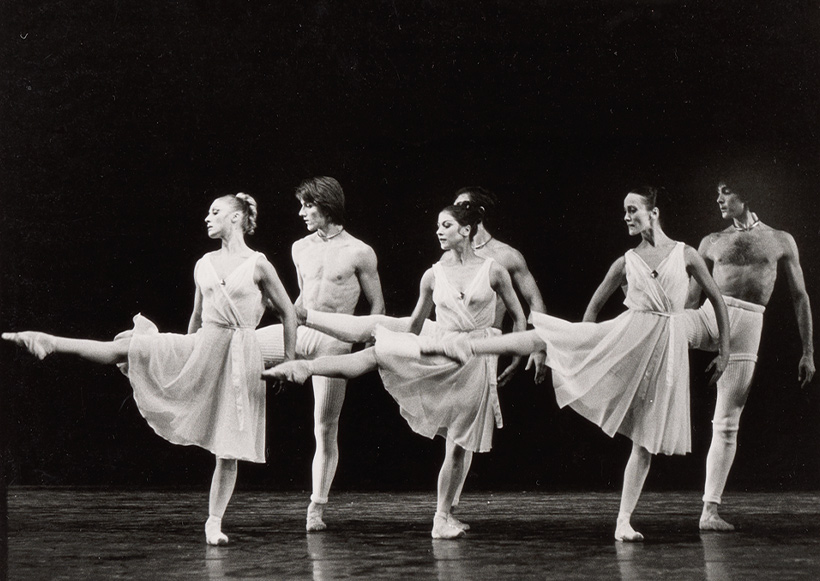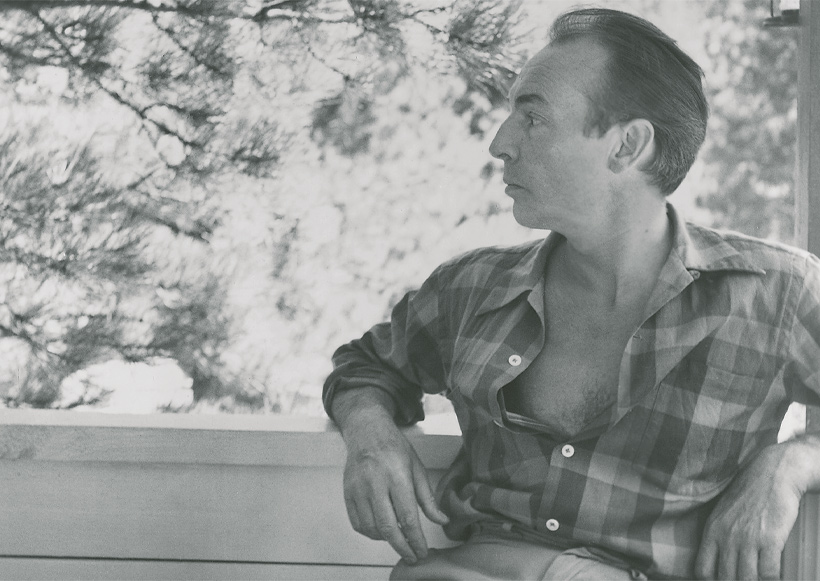
Hans van Manen about George Balanchine: ‘Without ears, you don’t see anything’
In the early fifties – when Hans van Manen was still a dancer – he saw his first ballet by George Balanchine, and it was love at first sight. “From then on, every Balanchine ballet scored ten out of ten for me!” And the Russian-American great master, who passed away in 1983, still regularly looks over Van Manen’s shoulder. “For me, he’s the greatest – and always will be. But I do occasionally say, ‘And now you can clear off!’”
“I think Concerto barocco was the first ballet. No, actually I’m sure it was. I saw it in the Stadsschouwburg, in Amsterdam”, says Hans van Manen about his first Balanchine experience. “At the time, I’d probably just started dancing with the Ballet of the Nederlandse Opera, which had an extensive repertoire, but I knew immediately that this was of a totally different order! I was bowled over straight away. What struck me most was that everything was so clear. And then the way he used the group of dancers, getting two women to dance a duet – in those days already – and how musical the whole choreography was. At the time, I was already familiar with Bach’s Double Violin Concerto, and everything fitted perfectly. During that one performance, I immediately comprehended forever that a great master was at work here.”
Tongue-tied
That same week, Van Manen waited for the choreographer and artistic director of the recently founded New York City Ballet in the dressing room corridor of the Stadsschouwburg. “Just for something to say, I asked him how I could join his company as a dancer. To which he answered, very matter-of-factly, ‘You’ll have to come to the US and audition.’” But that never happened, says Van Manen. “Like Balanchine, I wanted to become a choreographer, and I didn’t see myself doing that in America. Not just because of the huge competition there, but also because I wanted to belong to one group, and there was much more opportunity for that in the Netherlands.”

Later, he says, he did meet Balanchine again on several occasions. Like in the seventies, when Wiener Staatsballett was dancing Balanchine’s Brahms-Schönberg Quartet and Van Manen’s Adagio Hammerklavier in the same programme, and director Gerhard Brunner invited the two choreographers – and other guests – to his house for dinner. Van Manen says, “I hardly dared say or ask anything. I was hugely impressed, and of course that can easily make you tongue-tied. But it was a wonderful evening nevertheless, because the conversation was great and ears are important too.”
Just too late and exactly on time
From that first introduction in the early fifties, Van Manen gave each subsequent Balanchine ballet ‘a full ten out of ten’. “Every single one is exceptional, and they’re all so fantastically different.” This meant that later, Van Manen would often say that Balanchine was always looking over his shoulder in the rehearsal studio. “That’s because”, says Van Manen, “he was ahead of me in being as clear as possible in every aspect of a ballet: in the solutions you need to find in a pas de deux, and in the way you deal with groups, etc. Without thinking about it, I learned that straight away. I immediately understood what he meant by ‘visibility’. You don’t need to understand dance at all. You read a Balanchine ballet like you read a good book: you just keep turning the pages, and at the end you’re extremely satisfied.”
Another thing that connects the two choreographers is their nerve in using a great diversity of music styles and pieces. Neither did they shy away from choosing music by Bach, for example, who – at the time – was still often regarded as ‘sacrosanct’ by music purists. Their taste did differ, however, and Balanchine once asserted that ‘the art of dance would be better off not venturing into Beethoven’s world’; an assertion that was completely overturned by Van Manen, when he choreographed Adagio Hammerklavier in 1973. Van Manen says, “Balanchine was also interested in rodeo, American folk music, Broadway and the circus. Whereas I made works to music by The Rolling Stones, James Brown and John Cage.” But something the two definitely share is their love of jazz and swing. Van Manen says, “If you see that the steps really fit the music – as in the case of Balanchine – then it swings. Swinging is being just too late and exactly on time. Then you create space between the notes as well, and that’s essential for swing.”
Humor is essential
Asked what his favourite Balanchine ballet is, Van Manen finds it hard to say, but he admits, “I do get quite excited by his Violin Concerto. You understand exactly where it all comes from. The ‘folk dance bits’ in it, the eye contact, the humour and the way Karin von Aroldingen (a dancer from the original cast – ed.) waves playfully to the others when she comes on in the finale – it’s all so ingenious.” Even in the most serious of ballets, says Van Manen, humour is essential. “As a choreographer, you have to be able to distance yourself, and humour helps with that. And anyway, every joke you tell has a grain of truth in it.”

In Van Manen’s opinion, The Four Temperaments is also a masterpiece. In the programme with virtually the same name, it precedes Van Manen’s Frank Bridge Variations. “It’s a wonderful ballet, although I can never quite explain why.” He goes on to try, nevertheless, quoting Balanchine: ‘See the music, hear the dance’. “People always think you need your eyes for ballet, but without your ears you don’t see ballet. It’s like the lift in the hallway where I live. When I’m in my apartment (quite a distance from the lift – ed.), I can ‘see’ everything. I can hear from every ‘click’ or ‘plop’ whether the lift is coming from up or down, and from which floor.”
Stealing’s okay, but imitating isn’t
However great Van Manen’s admiration, he says he’s never copied a single step from Balanchine. “His ballets were just an enormous source of inspiration. Although actually, I really hate the word ‘inspiration’. Following Picasso and Stravinsky, I prefer to say, ‘I steal wherever I can’. That means you’re allowed to steal, but not to imitate. You see something in an artwork by someone else, which that person hasn’t seen themselves, and then you take it a step further or do something totally different with it.”
And that applies not only to Balanchine, but also to other choreographers who have ‘inspired’ him. “Jerome Robbins and Martha Graham too.” And as Alexandra Radius and Han Ebbelaar remark in the recently published book Levensdans: Van Manen has certainly absorbed something of the French style and virtuosity as well, as he was formed as a dancer partly by Françoise Adret (artistic director of the Ballet of the Nederlandse Opera at the time) and danced for a brief period with Roland Petit’s Les Ballets de Paris. Van Manen says, “If Han and Lex think that, then there must be some truth in it. I’ve never been crazy about the urge the French have to tell stories in dance, but of course you always come from somewhere. You can’t progress without your past.”
So Balanchine is not the only one regularly looking over his shoulder during rehearsals, he says. “Picasso and Stravinsky do it too, and a hell of a lot of others besides. But not for the whole hour and a half. Only when you get stuck and think, ‘how would so-and-so have solved it?’ And anyway I get some pretty critical observers over that shoulder of mine. They can also start to get irritating if they’re not needed. So I have no qualms about saying ‘sod off’ once in a while! Even to the greatest master of them all – Balanchine.”
The last of the Mohicans
If Balanchine hadn’t passed away at the age of seventy-nine, would he have carried on choreographing into his later years, like Van Manen himself? “I should think so! As an artistic director, he had his own group, and then you have a responsibility to give that group new works to dance. But actually, it doesn’t matter. The fact that his ballets are still danced all over the world means he’s still at work, as it were.”
“Nevertheless, you do sometimes realise they’re no longer with us: Balanchine, Robbins, Merce Cunningham. I’m the last of the Mohicans. Even though I, too, have stopped choreographing new works. It seems the sensible thing to do. There comes a time for looking back and gaining an overview, and that’s what I’ve been doing in recent years.”
New York, New York
Balanchine’s ballets and Van Manen’s ballets are still danced worldwide, and in Van Manen’s case by an increasing number of prominent companies in recent years, including some in the United States. Nevertheless, 2022 was the first time in many years that Dutch National Ballet had performed a Van Manen ballet in New York. At the renowned Fall for Dance Festival, the maestro and the four dancers from his Variations for Two Couples were showered with thunderous applause by a rapturous audience at New York City Center, which was sold out for two nights.
Van Manen, ignoring all the success for a second, says, “There was one terrible review, where the critic talked about irons, as apparently he’d never seen that you can also do a big lift in a pas de deux close to the ground.” But he adds proudly, “The rest raved, and of course it was fantastic to stand there in front of such an ecstatic crowd. Because”, he says, “even if the New Yorkers agree that New York is no longer New York, it’s still NEW YORK!!! You realise that when you’re standing there. After all, it is – and always will be – the city my great role models came from. With Balanchine in the lead.”
Text: Astrid van Leeuwen
- Four Temperaments will be performed at Dutch National Ballet from 16 September to 30 September 2023